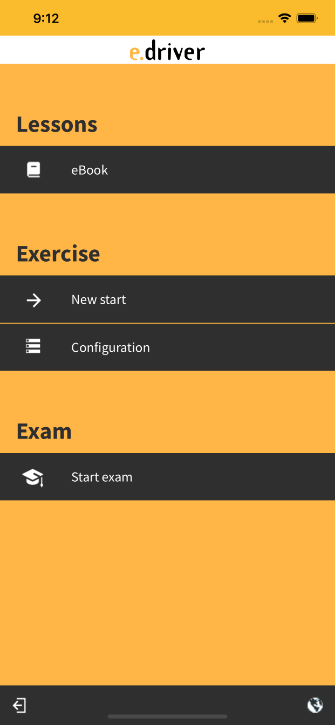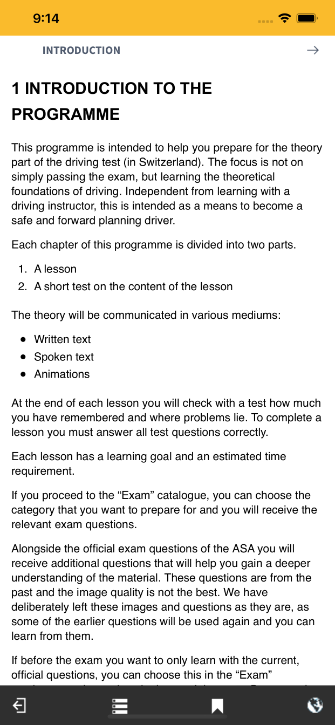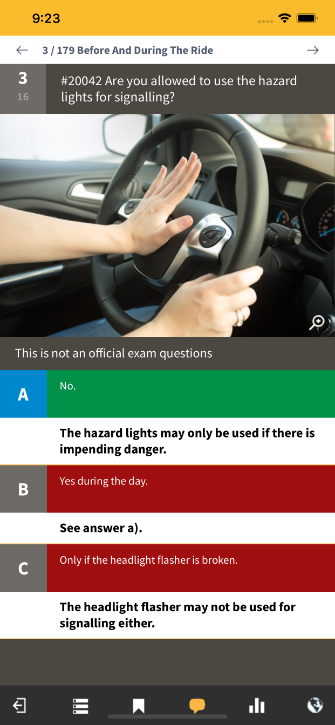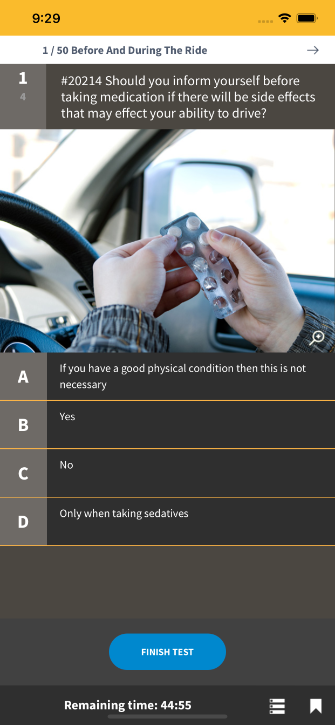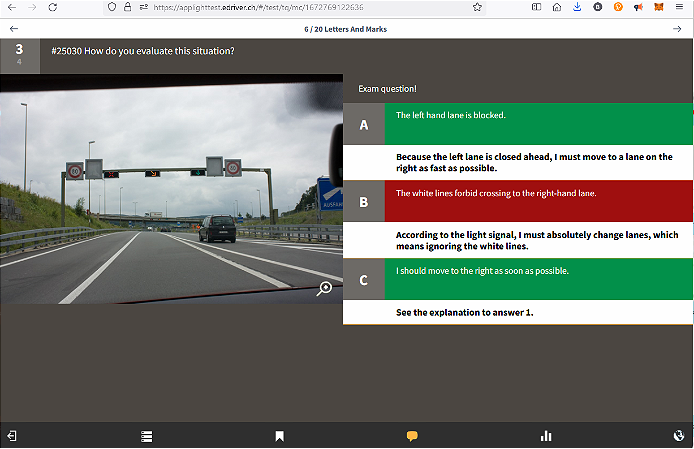e.driver theory test for cars, motorbikes, scooters, moped, tractors and construction vehicles
Preparation for the Swiss car theory test for motor vehicle drivers Cat. A1, A, B, M, F and G, available in English, German, French and Italian. As the first and only learning programme for the theory test, it includes audio, visual and practical components. Learning online for the driving theory test has been made easy.
Below are some demo questions from e.driver. Just click on a question to show possible answers.
- Question 1 - What should be kept in mind after fitting new tyres?
a) The increased danger of skidding in the first kilometres
b) A shorter stopping distance
c) To greatly increase the air pressure
Correct answer: a)
New tyres have a protective layer to protect them during storage. Until this layer has been worn off, there is an increased danger of skidding. On top of this the wheel bolts should be checked after 50-100 km.
- Question 2 - Persons over 7 years old must wear a seatbelt when sitting on which seats?
a) Only the front seats
b) Only on the back seats
c) On the front and back seats
Correct answer: c)
The driver and all passengers must always wear a seatbelt, regardless of what seat they are on.
- Question 3 - Which statement is correct?
a) A marking is needed if the load hangs over the rear end by more than 1m.
b) For cars, the load must never hang off the rear end.
c) If the load is secured, it is allowed to drive like this.
correct answer: a)
Customers have access to all language versions (EN, DE, FR, IT). In English, the following are currently available online:
- Lessons
- Test questions (translated from the original German version of the Department of Transportation)
Get Confidently Through the Driving Theory Test Thanks to
- The official test questions of the Department of Transport
- Expert commentary on the official test questions and 700 further test questions, making learning online for the theory exam easy!
- Windows and smartphone app (iPhone/iPad, Android, Windows Phone) for all test questions. Learn easily on the go.
- eBook lessons for desktop, tablets and smartphones
- Online expert forum: ask questions and get answers from experts
- Multimedia car theory lessons with spoken text
- Adaptive learning system
- Success guaranteed
Learn for the Swiss Driving Theory Test Online
Up to date original questions of the car theory test from the ASA (Association of Departments of Transport). All questions have commentary from test experts and the answers are explained. Over 15 months free access to the expert forum to ask driving instructors questions. The adaptive learning system is the optimum way to train. Effective and comprehensively learn for the Swiss driving theory exam. According to Sebastian Leitner’s adaptive learning system, harder questions are asked more frequently, depending on understanding. Available online over the web and as an app (iPhone/iPad, Android, Windows Phone).
Lessons
The Swiss driving theory exam is explained with an attractive, multimedia method. Furthermore, you can have the texts of the theory lessons read to you. Every one of the 13 lessons is conclude with a test to check how much has been learned. The lessons are also available as an eBook for iBook (iPhone, iPad), CoolReader (Android) and freda (Windows Phone).
Success Guaranteed
If you fail the driving theory test despite getting a score of 90% correct answers when using e.driver, we guarantee a complete refund within 120 days of purchase.
*Alternatively you can also upgrade to the newest test questions for free, if you have not passed the driving test within 15 months. This can be done up to 3 years after purchase.
- > Links and blogs
How can driver fatigue best be avoided?
Fatigue at the wheel is a major concern, especially for anyone preparing for their driver’s license. It often leads to serious accidents due to lack of concentration or micro-sleep. Since accident prevention is an important part of the driving theory exam, it is essential to understand how to avoid tiredness while driving. As simple as it may sound, taking regular breaks is the most effective way to combat fatigue. Strong coffee and energy drinks offer only short-term relief. A power nap—ideally lasting no more than 15 to 20 minutes—is also a proven strategy to stay alert and safe on the road.
Is it allowed to eat while driving?
Now that it’s holiday season, many of us are taking longer trips. But is it permitted to eat and feed yourself while driving? No, when driving, your hands should always stay on the wheel, and your focus should remain on the traffic. It’s also advisable to take regular breaks where you can not only eat and drink in peace but also relax for a while. Knowing the correct behaviour while driving is an important topic for the drivers license theory test. By the way, you can prepare particularly well for it with our e.driver learning program.
What should you do in this situation?
Imagine there are children playing near the road who are clearly not paying attention to traffic. How should you react?
In this situation, you must reduce your speed and, if necessary, use your horn or even stop completely. Questions like this often appear in the Drivers license theory exam, as the topic of children and other road users is very important.What makes areas of light and shadow problematic?
Road sections with many light and shadow patterns have the disadvantage that other road users are often hidden from view. That’s why it’s recommended to drive with dipped headlights even during the day and in sunny weather. This helps prevent dangerous situations or even accidents. Accident prevention is, by the way, also an important topic when preparing for your driver’s license.
Is it allowed to overtake in this situation?
Let’s say a pedestrian is crossing the road from the right – are you allowed to swerve left and pass? No, that is not permitted. Pedestrians who are on or approaching a pedestrian crossing always have the right of way. Passing them is prohibited, as it could lead to dangerous situations.
During the practical test, the safety of others is taken very seriously. But even in the theory section of the Drivers license exam, it is important to know how to behave correctly at a pedestrian crossing.What is the correct reaction in this situation?
During the Drivers License theory test, many questions deal with very specific traffic scenarios. Imagine a blind person standing at the side of the road, raising their white cane to indicate they want to cross. What is the correct way to react? In general, the blind person has the right of way and is allowed to cross the road, even if there is no pedestrian crossing at that spot. What you should not do: honk. Turning off the engine is also incorrect, as the blind person would not be able to hear whether the vehicle has stopped.
How should you behave at a pedestrian crossing without a traffic island?
Imagine you're driving in an urban area and approaching a pedestrian crossing where someone is waiting to cross. In Switzerland, the rule is clear: pedestrians always have the right of way – even if they haven’t yet stepped onto the crossing. You must adjust your speed in good time and stop if necessary. Hesitating or braking too late puts others at risk and can result in a fine. When preparing for your drivers license test, it's important to understand this rule well – it’s a common topic in the theory exam.
What is the maximum roof load allowed?
The roof load negatively affects vehicle handling in curves and increases fuel consumption. Therefore, there is a legal limit on roof loads. No more than 50 kg should be transported on the roof, or the maximum load specified in the vehicle registration should not be exceeded. If you are preparing for your Drivers License and studying car theory, it is important to understand weights and measures. In our e.driver learning program, this topic is extensively covered in theoretical lessons and test questions to ensure you are optimally prepared.
How to Prepare Effectively for the Driving Test
If you want to pass your drivers license test, it is important to study regularly and understand the traffic rules. With the e.driver learning program, you can practice with hundreds of test questions and strengthen your theoretical knowledge. Careful preparation helps you succeed in the test and drive safely on the road.
Do I have to give way to the bus?
If a public bus is stopped on the right side at a bus stop within a town and indicates with its turn signal that it wants to depart, you must give way to the bus. In all other situations, buses do not have any special right of way. Right of way and correct interaction with other road users are central topics when preparing for the Drivers License. To achieve this goal, we recommend that, in addition to driving school lessons, you use a high-quality learning program such as e.driver from e-university.
What should I do when the hazard lights come on?
Imagine you're driving on the motorway and the hazard lights of the vehicle in front of you turn on. In this case, you're probably approaching a traffic jam. You should slow down significantly and switch on your own hazard lights to warn the traffic behind you. Since motorway driving is an important topic in the Drivers License theory, our e.driver learning program includes a dedicated chapter on this subject.
Where must the wheels be positioned?
When you want to park in a marked parking space, it is very important to know exactly where the wheels must be placed. They must be entirely within the parking space. This is stated in the Traffic Signs Ordinance, which deals with road markings and, above all, with traffic signs in Switzerland. Anyone preparing for the Drivers License theory exam must, of course, know all the traffic signs and understand how to behave correctly.
Which lights must I use when being overtaken?
For a successful Drivers License theory test, it is important to know when to use which lights. Imagine you are being overtaken at night by another car. Which lights should you switch to? To prevent the driver of the overtaking vehicle from being dazzled, you must switch from high beam to low beam as soon as the car is level with your own. This way you avoid blinding the driver of the overtaking vehicle.
- drivers-license
- driving-license-test
- driving-license-theory
- driving-license
- driving-school-geneva
- driving-school
- driving-test-questions
- driving-test
- driving-theory-test
- driving-theory
- swiss-driving-license
- swiss-driving-school
Drivers license
Drivers license
